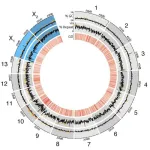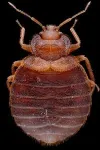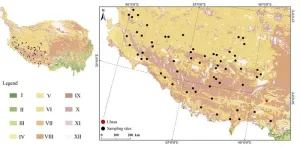(Press-News.org) Bedbugs. Just mentioning the tiny, biting insects that live on human blood and infest mattresses, couches, and bedding strikes fear into most people. In addition to the anxiety, itching, and rashes an outbreak can cause, bedbugs can be difficult to identify and expensive to treat.
Thanks to a new University of Texas at Arlington study published in the Journal of Heredity, scientists now have a better genetic understanding of the insect. The research offers an updated genome analysis of the common bedbug Cimex lectularius, providing new insight for those working to prevent bedbug infestation, develop remediation strategies and track pesticide resistance.
“This new high-quality reference genome provides a valuable resource for enhancing scientific investigations into this medically and economically resurging pest,” said author Todd Castoe, professor of biology at UTA.
“We now have an important additional tool for studying patterns of human-associated evolution and adaption for this insect that has wreaked havoc on human populations since the beginning of civilization,” added co-author Yannick Francioli, a Ph.D. student in Dr. Castoe’s lab.
Although bedbugs have been mentioned in the written record for more than 3,000 years, the pest rose to prominence 1940s, when infestations plagued military bases during World War II. With the introduction of the powerful pesticide DDT (dichlorodiphenyltrichloroethane), the insect was thought to be eradicated in many industrialized nations.
In the 1990s, a combination of the elimination of DDT use due to health concerns, increased pesticide resistance among insects, and increased international travel helped fuel a resurgence of bedbug infestations. Bedbug outbreaks around the world now routinely make news headlines, such as the infestation in Paris hotels before the summer 2024 Olympic Games.
To better understand the genetics of the bedbug, Castoe and Francioli, along with researchers from Virginia Polytechnic Institute and State University, the University of Arkansas, the Dana-Farber Cancer Center, Harvard Medical School, and the Broad Institute of Massachusetts Institute of Technology and Harvard University, obtained a sample specimen of the insect and flash froze it to allow its DNA to be extracted.
From that extraction, the team was able to create a chromosome-level reference genome for the insect using PacBio long-read and Omni-C proximity genetic sequencing tools. This approach, combined with sampling additional male and female individuals, allowed the team to map a contiguous bedbug genome with 15 chromosomes (13 autosomes and two sex chromosomes: X1 and X2), providing a comprehensive genetic map that enhances our understanding of the pest’s biology, evolution and insecticide resistance.
Specifically, the identification of the sex chromosomes will help researchers understand the genetic basis of sex determination in bedbugs. This can be particularly useful for developing targeted pest control strategies that exploit sex-specific traits.
“The creation of a chromosome-level reference genome gives us a new and highly accurate contiguous map of the bedbug's genetic material,” said Castoe. “This new foundational resource will allow researchers to further understand the genetic basis of traits for the insect that cause issues such as insecticide resistance, which is crucial for developing more effective pest control strategies.”
This research was supported by the National Science Foundation Division of Environmental Biology (DEB-1754394), startup funds from the University of Tulsa and Virginia Polytechnic Institute and State University, and the Joseph R. and Mary W. Wilson Urban Entomology Endowment. Additional funding came from a National Science Foundation Doctoral Dissertation Improvement Grant (DEB-1401747).
About The University of Texas at Arlington (UTA)
Located in the heart of the Dallas-Fort Worth Metroplex, The University of Texas at Arlington is a comprehensive teaching, research, and public service institution dedicated to the advancement of knowledge through scholarship and creative work. With an enrollment of approximately 41,000 students, UT Arlington is the second-largest institution in the UT System. UTA’s combination of outstanding academics and innovative research contributes to its designation as a Carnegie R-1 “Very High Research Activity” institution, a significant milestone of excellence. The University is designated as a Hispanic Serving-Institution and an Asian American Native American Pacific Islander-Serving Institution by the U.S. Department of Education and has earned the Seal of Excelencia for its commitment to accelerating Latino student success. The University ranks in the top five nationally for veterans and their families (Military Times, 2024), is No. 4 in Texas for advancing social mobility (U.S. News & World Report, 2025), and is No. 6 in the United States for its undergraduate ethnic diversity (U.S. News & World Report, 2025). UT Arlington’s approximately 270,000 alumni occupy leadership positions at many of the 21 Fortune 500 companies headquartered in North Texas and contribute to the University’s $28.8 billion annual economic impact on Texas.
END
Detailed bedbug genome analysis may improve pesticides
UT Arlington study sequencing the pest’s genome may help prevent outbreaks
2024-12-16
ELSE PRESS RELEASES FROM THIS DATE:
Exploring the impact of probiotics on gut microbiota disruption caused by antibiotics
2024-12-16
Antibiotics are important clinical tools for treating bacterial infections, yet we recognize that an important side effect of antibiotic use is disruption of the microbial community living in the human gut. Antibiotics targeted against bacterial pathogens generally have the secondary effects of decreasing certain groups of bacteria and lowering gut microbiota diversity. Antibiotics are also associated with harms such as antibiotic associated diarrhea and C. difficile colitis. Probiotics have been shown to mitigate these clinical scenarios, but can probiotics help restore the microbiota?
In ...
Shrubs can help or hinder a forest’s recovery after wildfire
2024-12-16
Research from the University of California, Davis, is shedding light on when and where to plant tree seedlings to help restore forests after high-severity wildfires, and it has a lot to do with shrubs.
In hotter, drier areas where natural regeneration is weaker, well-timed tree planting can boost recovery by up to 200%, but the outcome also depends on competition with shrubs, a paper in the journal Forest Ecology and Management concludes.
“Generally, where there are more shrubs, the climate and soil are more hospitable for plant growth,” ...
DOE’s RENEW initiative to support seven Pathway Summer Institutes for Educators of underrepresented and underserved groups in STEM
2024-12-16
The U.S. Department of Energy’s (DOE) Office of Science (SC) will support nearly 85 educators who either teach at schools and community colleges with large populations of students historically underserved and/or underrepresented in STEM or are educators who are from groups traditionally underrepresented in STEM through awards for seven Pathway Summer Institutes for Educators at seven national laboratories.
The funding comes from SC’s Reaching a New Energy Sciences Workforce (RENEW) initiative (see details at https://science.osti.gov/initiatives/RENEW).
Sponsored by the Office of Workforce Development for Teachers and Scientists (WDTS), ...
Toward quantum for the real world: Photonic team in running for center-level funding
2024-12-16
Images
Michigan is a contender for a $50 million center aiming to build a quantum technology robust enough for the real world and demonstrate its utility. With a $1 million grant to explore options over the next year, the Michigan-led team is one of 11 funded in the first phase of the National Science Foundation's Quantum Science and Technology Demonstrations.
The team, whose project is called Quantum Photonic Integration and Deployment, or QuPID, aims to build the first chips that harness the incredible precision of light for real-world measurements in the field with quantum semiconductors. Working with leading industrial ...
Inaugural ceremony for KIT’s new president, Jan S. Hesthaven
2024-12-16
View this album for photos of the event.
Hesthaven, a 58-year-old Dane, noted in his inaugural speech that KIT had a duty to be of service to society and that it faced major changes and challenges. “Increased internationalization will play a key role. We need to ensure that KIT attracts talent not only from Germany but also from around the world,” he said. The President named three challenges confronting society: new health technologies for an aging population, the spread of artificial ...
Plant DNA metabarcoding unlocks vegetation secrets of the Tibetan plateau
2024-12-16
A recent study led by Dr. Li from Zhejiang Normal University, in collaboration with international researchers, reveals the potential of plant DNA metabarcoding for monitoring plant compositions on the Tibetan Plateau (TP). The study, published in Science China Earth Sciences, highlights the advantages of sedimentary DNA (sedDNA) extracted from lake sediments over traditional pollen analysis, providing a more detailed and localized perspective on vegetation monitoring and reconstruction.
The study involved the surface sediments from 59 small lakes and ponds located in the southwestern Tibetan Plateau. Using plant DNA metabarcoding, ...
MSU study highlights negative impact of COVID-19 pandemic on special education students in Michigan
2024-12-16
MSU has a satellite uplink/LTN TV studio and Comrex line for radio interviews upon request.
EAST LANSING, Mich. – The COVID-19 pandemic adversely impacted K-12 education and its effects have been well documented. However, there has been less focus on how the pandemic affected the special education system and, specifically, that system here in Michigan.
To provide more insight and data, researchers at Michigan State University’s College of Education published a new study exploring learning gaps for students with disabilities and especially for those ...
VCU secures $9 million grant to establish Cancer Control Equity Research Center in Virginia
2024-12-16
Virginia Commonwealth University (VCU) has been awarded a five-year, $9 million grant from the National Cancer Institute to establish a pioneering Cancer Control Equity Research Center. This initiative aims to enhance the dissemination and implementation of health promotion and cancer prevention services for individuals and families residing in Virginia's Housing and Urban Development (HUD)-administered income-based housing communities in the Greater Richmond region and Hampton Roads.
Adults in under-resourced communities are placed at disproportionate risk for cancer, facing a higher incidence of the disease ...
AgriLife Research leads collaboration to address zebra chip disease
2024-12-16
Texas A&M AgriLife Research scientists are working on a new research project to fight plant diseases transmitted by psyllid insects — particularly the zebra chip disease, which has impacted potato production for decades.
Funded by a $682,500 grant from the U.S. Department of Agriculture National Institute of Food and Agriculture, this three-year project will investigate the mechanisms through which the bacterial pathogen Candidatus Liberibacter solanacearum affects plant and insect immune systems, leading to agricultural losses.
The findings by researchers in the Texas A&M College of Agriculture and Life Sciences could ...
New drug shows promise against Duchenne muscular dystrophy
2024-12-16
A novel drug holds promise for treating Duchenne muscular dystrophy (DMD), a rare genetic disorder that causes severe muscle degeneration.
McGill University researchers have discovered that an experimental compound called K884 can boost the natural repair abilities of muscle stem cells. Current treatments can slow muscle damage, but don’t address the root problem.
DMD affects about one in 5,000 boys worldwide, often leading to wheelchair dependence by the teenage years and life-threatening complications ...
LAST 30 PRESS RELEASES:
Understanding the role of linear ubiquitination in T-tubule biogenesis
Researchers identify urban atmosphere as primary reservoir of microplastics
World’s oldest arrow poison – 60,000-year-old traces reveal early advanced hunting techniques
Bristol scientists discover early sponges were soft
New study uncovers how rice viruses manipulate plant defenses to protect insect vectors
NSF–DOE Vera C. Rubin Observatory spots record-breaking asteroid in pre-survey observations
Ribosomal engineering creates “super-probiotic” bacteria
This self-powered eye tracker harnesses energy from blinking and is as comfortable as everyday glasses
Adverse prenatal exposures linked to higher rates of mental health issues, brain changes in adolescents
Restoring mitochondria shows promise for treating chronic nerve pain
Nature study identifies a molecular switch that controls transitions between single-celled and multicellular forms
USU chemists' CRISPR discovery could lead to single diagnostic test for COVID, flu, RSV
Early hominins from Morocco reveal an African lineage near the root of Homo sapiens
Small chimps, big risks: What chimps show us about our own behavior
We finally know how the most common types of planets are created
Thirty-year risk of cardiovascular disease among healthy women according to clinical thresholds of lipoprotein(a)
Yoga for opioid withdrawal and autonomic regulation
Gene therapy ‘switch’ may offer non-addictive pain relief
Study shows your genes determine how fast your DNA mutates with age
Common brain parasite can infect your immune cells. Here's why that's probably OK
International experts connect infections and aging through cellular senescence
An AI–DFT integrated framework accelerates materials discovery and design
Twist to reshape, shift to transform: Bilayer structure enables multifunctional imaging
CUNY Graduate Center and its academic partners awarded more than $1M by Google.org to advance statewide AI education through the Empire AI consortium
Mount Sinai Health system receives $8.5 million NIH grant renewal to advance research on long-term outcomes in children with congenital heart disease
Researchers develop treatment for advanced prostate cancer that could eliminate severe side effects
Keck Medicine of USC names Christian Pass chief financial officer
Inflatable fabric robotic arm picks apples
MD Anderson and SOPHiA GENETICS announce strategic collaboration to accelerate AI-driven precision oncology
Oil residues can travel over 5,000 miles on ocean debris, study finds
[Press-News.org] Detailed bedbug genome analysis may improve pesticidesUT Arlington study sequencing the pest’s genome may help prevent outbreaks





